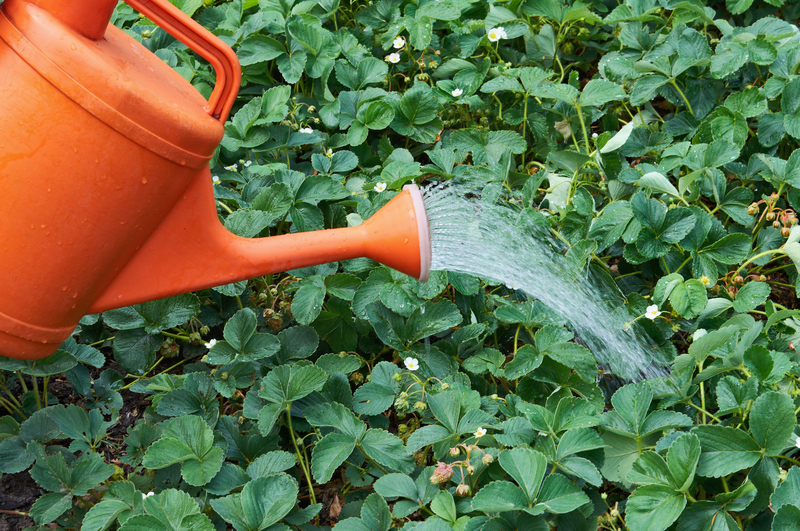Strategies for Managing Strong Winds in Your Garden
Posted on 11/09/2025
Strategies for Managing Strong Winds in Your Garden
Strong winds can spell disaster for gardens of all sizes, snapping stems, stunting growth, and making your outdoor space inhospitable. If you live in a breezy region, learning effective strategies for managing strong winds in your garden is essential to cultivate healthy plants and maintain a thriving landscape.
Understanding the Impact of Strong Winds on Gardens
Wind is a natural element, but high-speed gusts can wreak havoc on everything from delicate flowers to robust trees. The key is to understand how wind affects your plants and garden structures, so you can implement the best wind management solutions.
How Wind Damages Gardens
- Physical Damage: Strong winds can break branches, uproot young plants, and shred leaves.
- Water Loss: Wind increases evaporation, drying out soil and plant tissues, leaving plants thirsty.
- Soil Erosion: Persistent wind can blow away topsoil and mulch, depleting your garden's nutrients.
- Pest and Disease Spread: Wind transports fungal spores, seeds, and insects into your garden.
By prioritizing wind management in your gardening plan, you can ensure not only plant survival but also flourishing growth.

Garden Wind Management Strategies
1. Plan Your Garden Layout with Wind in Mind
Before planting, observe the direction and intensity of prevailing winds in your area. Arrange your garden so that taller, hardier plants act as windbreaks for more delicate species. Grouping plants together can also foster mutual protection.
- Use fences and existing structures such as sheds, garages, or walls as part of your wind management strategy.
- Create microclimates by positioning plants in sheltered spots where possible.
- Plant in clusters rather than rows to disrupt wind flow and reduce damage.
2. Utilize Effective Windbreaks in Your Garden
One of the cornerstones of strong wind management for gardens is installing windbreaks. These features act as barriers that slow down or deflect wind, providing a calm area where plants can thrive.
- Living Windbreaks: Plant rows of dense shrubs, hedges, or trees. Consider species such as juniper, privet, leylandii, or holly for year-round protection.
- Hardscaping Windbreaks: Solid fences, lattice screens, or walls can serve as immediate windbreaks. For best results, opt for permeable materials like slatted wood that let some wind pass through, reducing turbulence.
- Temporary Windbreaks: Use burlap screens, garden fabric, or mesh to protect newly planted areas until permanent solutions establish themselves.
Pro-tip: The most effective windbreaks are about 50% permeable, standing at least as tall as the plants you wish to protect.
3. Anchor and Support Vulnerable Plants
In areas prone to gusty conditions, keep your plants upright and protected with proper anchoring:
- Staking: Secure tall or top-heavy plants, new trees, and climbing vines with stakes. Use soft ties and allow gentle movement to encourage stronger root development.
- Caging: Encase more fragile flora in wire or bamboo cages to buffer them from direct wind impact.
- Guying Large Trees: Use strong wires anchored to the ground to support saplings or newly transplanted trees during their establishment phase.
*Remember to check ties and supports regularly to prevent girdling or damage as plants grow.*
4. Choose Wind-Resistant Plants
Not all plants are equally affected by wind. Incorporate wind-tolerant species into your garden design to naturally mitigate wind problems.
- Flexible Grasses: Ornamental grasses like miscanthus and pampas are adapted to swaying in strong winds.
- Compact Shrubs: Boxwood, hebe, and lavender are typically resilient against wind.
- Sturdy Trees: Oaks, pines, and certain maples hold up well in blustery weather.
Avoid planting large-leaved or brittle-stemmed plants directly in the wind's path. Their structure makes them more susceptible to tearing and breakage.
5. Mulch and Protect Your Soil
Wind can quickly dry out exposed soil and blow away top layers. Conserving soil moisture and preventing erosion is critical.
- Mulching: Apply a thick layer of bark chips, straw, or compost to garden beds. This not only fixes the soil but also helps retain moisture.
- Ground Covers: Plant low-growing species like creeping thyme or vinca minor to hold the soil in place.
- Edging: Install stones, logs, or other borders to prevent mulch and soil from blowing away.
Innovative Garden Wind Management Solutions
Integrate Vertical Gardens and Green Walls
Vertical gardens can double as wind barriers while maximizing your planting space. Use trellises, living walls, or stacked planters with robust species to disrupt wind currents and shelter more fragile plants behind.
Design Strategic Pathways and Raised Beds
Garden paths and raised beds can break up airflow, diffusing wind intensity. Raised beds are particularly useful in windy zones, as they:
- Makes plant care easier and more accessible.
- Allows for improved drainage and warmth retention.
- Helps protect roots and stems from direct wind exposure.
Leverage Water Features as Wind Diffusers
Including water features, such as fountains or small ponds, can change wind patterns slightly, providing a buffer for certain sections of your garden. The movement of water can also help rehydrate microclimates, offsetting the drying effects of constant wind.
Seasonal Wind Garden Maintenance Tips
Prepare for Storms and Peak Wind Seasons
Anticipate stormy periods and strong seasonal winds by implementing temporary wind management techniques:
- Install removable windbreaks before high wind events, then dismantle them in calm seasons for better sunlight access.
- Harvest mature fruits and flowers early to avoid loss due to storm damage.
- Secure all loose garden furniture, tools, and decorations to prevent them from becoming wind-borne hazards.
Regular Pruning and Plant Care
Keep plants pruned of weak or dead branches, which can become projectiles or cause damage during storms. Pinch back vigorous annuals to promote bushier, lower growth less affected by wind.
How to Monitor and Assess Wind Conditions in Your Garden
Gather and Use Wind Data
Use weather apps, local climate data, or set up your own garden anemometer and wind vane to monitor wind strength and direction over time. This valuable data helps inform garden design decisions, plant placement, and the timing of protective measures.
Observe and Adjust
Regularly walk through your garden after windy days. Take note of:
- Where debris accumulates
- Which plants are most affected
- Areas of exposed soil or erosion
Use this insight to continuously improve your wind protection strategies.
Common Mistakes to Avoid When Managing Wind in Your Garden
- Using solid barriers exclusively: Solid barriers can cause turbulence and wind tunnels. Always opt for a mix of permeable and solid structures.
- Neglecting young plants: Newly planted specimens are most vulnerable. Prioritize their protection.
- Overcrowding: Cramming plants too closely reduces air circulation and can foster disease. Strive for a balanced layout.
- Ignoring soil quality: Healthy, well-mulched soil resists wind erosion far better than poor, dry ground.
Benefits of Effective Wind Management in Gardening
- Increased Plant Health and Yield: Healthy, less-stressed plants grow stronger and produce more fruit, flowers, or foliage.
- Improved Landscape Aesthetics: Fewer damaged leaves and stems mean a more attractive garden.
- Water Conservation: With less wind-driven evaporation, you'll save on irrigation.
- Lower Maintenance: Well-protected plants need fewer repairs and replacements.

Conclusion: Embrace Strong Wind Management for Garden Success
While strong winds present a unique challenge to gardeners, the right combination of planning, planting, and protection measures can transform even the breeziest backyard into a lush, sheltered retreat. With these comprehensive strategies for managing strong winds in your garden, you'll not only safeguard your plants but also create a more enjoyable and sustainable growing environment.
Adapt your approach seasonally, stay observant, and experiment with windbreaks, supports, and wind-resistant plantings. The extra effort will reward you with a healthy, resilient garden that withstands nature's breeziest moods.
Frequently Asked Questions About Wind Management in the Garden
-
What is the best material for garden windbreaks?
Answer: The most effective windbreaks are 50-80% permeable, such as slatted wooden fences, hedges, or woven mesh screens. -
Can container plants survive high winds?
Answer: Yes, but position containers in sheltered areas, use heavy pots to prevent tipping, and stake or cage top-heavy species. -
How high should a windbreak be?
Answer: A windbreak should be as tall as the area you want to protect; ideally, 6-8 feet for most gardens. -
Do strong winds damage all garden plants?
Answer: Some plants are more susceptible than others; selecting resilient varieties and providing support can minimize risk.
Thorough garden wind management ensures that your garden not only survives, but thrives--whatever the weather.

